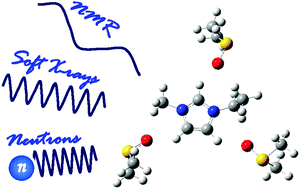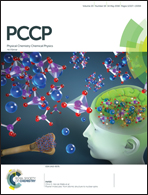Hydrogen bonds of the imidazolium rings of ionic liquids with DMSO studied by NMR, soft X-ray spectroscopy, and SANS
Abstract
The hydrogen bonds of the imidazolium-ring H atoms of ionic liquids (ILs), 1-alkyl-3-methylimidazolium bis(trifluoromethylsulfonyl)amides ([Cnmim][TFSA], n = 2 to 12 where n represents the alkyl chain length), with the O atom of dimethyl sulfoxide (DMSO) have been elucidated using 1H, 13C, and 15N NMR spectroscopy and soft X-ray absorption and emission spectroscopy (XAS and XES). Density functional theory (DFT) calculations have been performed on an isolated DMSO molecule and two cluster models of [Cnmim]+–DMSO by hydrogen bonding to interpret the XES spectra for the [Cnmim][TFSA]–DMSO solutions. The 1H and 13C NMR chemical shifts of the imidazolium ring showed that deshielding of the ring H and C atoms is moderate as the DMSO mole fraction xDMSO increases to ∼0.8; however, it becomes more significant with further increase of xDMSO. This finding suggests that the hydrogen bonds of the three ring H atoms with the DMSO O atoms are saturated in solutions with xDMSO increased to ∼0.8. The 1H and 13C chemical shifts of the alkyl chains revealed that the electron densities of the chain H and C atoms gradually decrease with increasing xDMSO, except for the N1-bound carbon atom C7 of the chain. The 15N NMR chemical shifts showed that the imidazolium-ring N1 atom which is bound to the alkyl chain is shielded with increasing xDMSO in the range from 0 to 0.8 and is then deshielded with further increase of xDMSO. In contrast, the imidazolium ring N3 atom is simply deshielded with increasing xDMSO. Thus, the electron densities of the alkyl chain may be condensed at the C7 and N1 atoms of [Cnmim]+ by the hydrogen bonding of the ring H atoms with DMSO. The hydrogen bonding of DMSO with the ring results in low-energy shifts of the XES peaks of the O K-edge of DMSO. Small-angle neutron scattering experiments showed that [Cnmim][TFSA] and DMSO are homogeneously mixed with each other on the mesoscopic scale. This results from the strong hydrogen bonds of DMSO with the imidazolium-ring H atoms.



 Please wait while we load your content...
Please wait while we load your content...